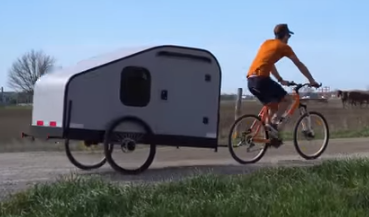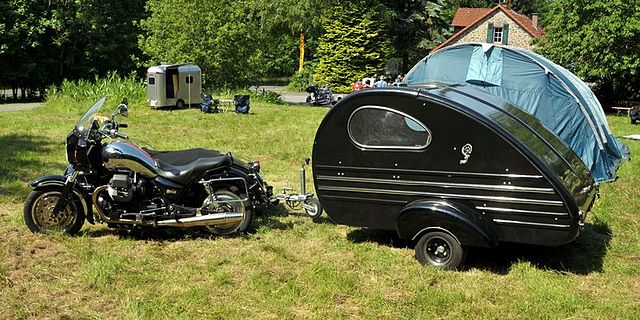 If you don’t have a truck or at least a medium-sized SUV, you may think that a camper isn’t an option for you. But, believe it or not, there are micro-campers meant to be pulled by a bicycle (or snowmobile or even by sheep!). Most people would view these as very temporary shelters, but one example shows that you can live out of one longer than you would think. A lot is going to depend on your climate, how much you can tolerate roughing it, and if you have access to places where you can set it up for longer periods of time.
If you don’t have a truck or at least a medium-sized SUV, you may think that a camper isn’t an option for you. But, believe it or not, there are micro-campers meant to be pulled by a bicycle (or snowmobile or even by sheep!). Most people would view these as very temporary shelters, but one example shows that you can live out of one longer than you would think. A lot is going to depend on your climate, how much you can tolerate roughing it, and if you have access to places where you can set it up for longer periods of time.
Hand-Pulled Camper
You can’t get much more basic than this. It is, admittedly, little more than a box on wheels, but it’s waterproof and has some insulation (and you can always have more than what he has; some foam panels could be put between the studs). He proves you can drag it through light woods, so maybe with some brown cladding (so it blends in), you can stealth camp in wooded areas and relocate periodically to avoid attracting attention.
At the very least, it shows you how to build one of these lightweight micro-campers using simple measurements and hand tools. (Although I wouldn’t use 4x4s on the corners; those are overkill for this sort of structure and add a lot of weight. The roof of this can’t carry a heavy snow load anyway because it’s flat.)
With a different tongue, and probably a bit larger wheels, it could be pulled with a bicycle or even a 4-wheeler if you want to go far into the woods.
Sheep-Powered Vardo
Aaron Fletcher lives a semi-nomadic lifestyle as a migrant farmhand. He both works other people’s farms and farms his own sheep like nomads since time immemorial. His homemade vardo (complete with wood burning stove) is pulled by the most unlikely of draft animals: a ram. Because he and the sheep are hoofing it, he is limited to no more than 5 miles of travel per day, so his nomad territory is fairly small and he runs a predictable route. He has regular customers for his sheep-based products and local farmers who need his work seasonally, so he moves where he is needed, camps out on his employer’s property or on a wide spot on the side of the road, and stays as long as there is work and grass for his sheep to graze.
Don’t have carriage sheep? Aaron says before he figured out that his ram could pull the wagon, he pulled it himself (although he says he was able to add a bit more weight to the wagon after making the switch).
Lightweight Bike Trailer from Recycled Campaign Signs
Paul Elkins has been experimenting with designs for lightweight bike trailers for years and has had success with one built primarily from the corrugated plastic signs used as political advertising and zip ties. He has downloadable plans if you prefer to work from measurements rather than just winging it. His total cost for the project was $150, but you might already have some of the needed material, allowing you to make it even more cheaply. The entire project was assembled with just a drill/screwdriver and saw, so you don’t need a lot of equipment or carpentry skills to make it. It is also the lightest of the bike trailers featured here, so you can pull it with a standard bike.
Cold Weather Bike Trailer
If you have a bit more money to spare and more-than-beginner fabrication skills, KreAir has plans for a more robust bike camper using an aluminum frame. This camper includes solar panels and a self-venting propane stove. With some additional insulation and the stove on low, it can stay a reasonable 68 degrees Fahrenheit inside when outside temps drop to around 0. It’s also tall enough to sit upright in, which may make this a better option for the more claustrophobic.
It is demoed with an electric bike, but it’s not clear if an electric bike is required to pull it or not. I would say definitely yes if you will be traveling in hilly terrain, but maybe not if you will be living where it is mostly flat.
Snowmobile Hut on Sleds
Speaking of snow and cold temps, if you live in the Great White North, a custom-built camper on sleds might be a better fit for you. This design is going to be even more expensive and require even more carpentry skills than the previous models, but plans are available.
Even if you don’t live in the Great White North, check out his homemade candle stove; it may be a good option for your own camper.
Micro Vardo
This little camper is easy to build with basic carpentry skills (the video walks you through the construction process) and can be done for $1,000 or less. The weight is such that it requires an e-bike, scooter or an ATV (which is what the owner uses) to move. If you build this on a small trailer frame and put a more robust roof on it, then it would be roadworthy and could be pulled by a motorcycle or small car.
If you don’t like the transparent roof for privacy reasons, you can get this same material in opaque colors. But, while easy to work with, it has practically no insulation factor, so if you are going to be living in it somewhere cold, definitely consider a roof you can insulate.
E-Bike Camper
The pinnacle in terms of cost and skill to build is Drew’s bicycle camper, which really does look like a mini-camper. This is also the heaviest of the bicycle trailers, so you are going to need an electric bike, at a minimum (a scooter is also an option) to pull it.
Even people who have the carpentry skills necessary to build this camper might not be able to weld the custom frame. Check Craigslist or business listings for freelance welders to knock the frame up for you. Drew sells plans which cover the entire build, including the frame.
Conclusion
Living in a micro-camper is not something you are going to want to do long-term, obviously, but if you anticipate being between homes for a short time, this would be a better option than living in a tent, as it can be better insulated, better waterproofed, better heated, and is somewhat safer in rough weather (and, in the case of the snowmobile hut, safer against wildlife). Also, pulling a little trailer behind your bicycle says “outdoor enthusiast” rather than “homeless vagrant,” which could make life easier for you when interacting with other people.
Are these options a little too small or impractical? Check out this post for more nomad options: On the Road Again – Exploring Nomadic Housing Options


